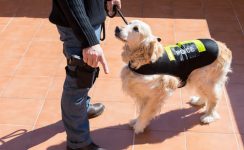Sniffer Dogs: False Positives and Limits to Police Powers

One of the most controversial tools in the armoury of police when it comes to enforcing drug laws is the use of drug detection dogs.
These dogs were introduced after the 2000 Sydney Olympics to catch drug suppliers, but have failed dismally to meet their stated objective. Rather, drug dog operations have led to tens of thousands of innocent people being subjected to invasive searches, while failing to deter drug dealers or users.
Indeed, government statistics suggest that more than two out of every three searches are ‘false positives’ – where the dog indicates the presence of drugs but none are found.
Perhaps of even greater concern, the use of sniffer dogs has been linked to the deaths of several young people at music festivals – who have ‘loaded up’ on significant quantities of drugs upon seeing dogs in the area, or ‘pre-loaded’ before arriving at the venue to avoid detection.
False Positives
In June 2006, NSW Ombudsman Bruce Barbour released his eagerly awaited “Review of the Police Powers (Drug Detection Dogs) Act 2001”.
That document examined 470 drug dog operations over two years, the majority occurring in greater Sydney. Its findings were highly critical of the use of drug detection dogs.
The review found that prohibited drugs were located in only 26 per cent of the recorded positive indications by drug dogs.
And of the 10,211 positive indications made, there were only 19 successful prosecutions for drug supply – which represented 0.19 per cent of those searched.
Barbour concluded that: “the use of drug detection dogs has proven to be an ineffective tool for detecting drug dealers”.
His findings were a significant blow to the primary justification for the use of sniffer dogs – which was to detect and prosecute those engaged in drug supply. The Ombudsman went on to state:
“We have recommended that NSW Police develop guidelines which outline the factors that, in addition to a drug detection dog indication, may be considered by a police officer when forming a reasonable suspicion to lawfully stop, search and detain a person.
“In addition, we have recommended that these guidelines be discussed at briefings before operations, and that officers systematically record the factors that led to the formation of reasonable suspicion.
“We have also recommended the removal of advice contained in current guidelines that police officers have reasonable suspicion to search a person based solely on a drug detection dog indication”.
(iii) The rate of detection since the Ombudsman’s report
Despite Mr Barbour’s scathing criticism of the operations, the number of searches performed after positive indications nearly doubled in the years following his review.
And government figures obtained by Greens MP David Shoebridge show that only around one-third of positive indications lead to drugs being found:
2007
Searches after positive indications: 7,603
Drugs found: 2,435
Percentage: 32%
2008
Searches after positive indications: 10,562
Drugs found: 3,748
Percentage: 35%
2009
Searches after positive indications: 17,321
Drugs found: 5,109
Percentage: 29%
2010
Searches after positive indications: 15,779
Drugs found: 5,087
Percentage: 32%
2011
Searches after positive indications: 18,281
Drugs found: 5,031
Percentage: 28%
2012
Searches after positive indications: 16,184
Drugs found: 5,280
Percentage: 33%
2013
Searches after positive indications: 17,746
Drugs found: 6,415
Percentage: 36%
2007 – 2013
Searches: 103,476
Drugs found: 33,105
Accuracy: 32%
Recent decrease in searches
In 2014, police performed 14,541 searches. This reduced to 12,893 in 2015, representing an 11 percent decrease in the space of a year.
However, the rate of false positive searches remained extremely high. In around 69 percent of searches in 2015, police did not find any illicit substances.
This means 8,874 individuals were subjected to searches by police in public, when they weren’t committing any offence.
The figures are a damning indictment of drug detection operations, and a growing number of people – including politicians – are coming to realise that sniffer dogs are ineffective, unjustifiably intrusive and can lead to dangerous behaviours like ‘loading up’ and ‘pre loading’.
Indeed on 20 May 2015, NSW Greens MP Jenny Leong introduced the Amendment (Sniffer Dogs-Repeal of Powers) Bill before parliament. If it had passed, the bill would have revoked NSW police powers to carry out drug dog searches in places like train stations and music festivals. However, it did not pass and the current regime remains in place.
Limits to Police Powers
Contrary to popular belief, police do not have the right to use sniffer dogs anywhere, anytime or any way they like.
A. Permitted places
Police are only allowed to use sniffer dogs in a ‘proscribed place’ or if they have obtained a warrant to use them.
Section 148 of the Law Enforcement (Powers and Responsibilities) Act 2002 (the LEPRA) permits police to use drug detection dogs without a warrant in the following places:
- Pubs, clubs, hotels or other licensed premises where alcohol is served;
- Entertainment events including music festivals;
- Public transport, bus routes and stations;
- Tattoo parlours; and
- In and around Kings Cross.
Otherwise, police must apply for a warrant under section 149 of the Act, which requires them to show an ‘authorised officer’, such as a magistrate, that they have “reasonable grounds for believing that the persons at any public place may include persons committing drug offences.
B. Requirement of reasonable suspicion
In general terms, section 21(1) of the LEPRA permits a police officer to stop, search and detain a person without a warrant if he or she “suspects on reasonable grounds” that a person is in possession of:
- something stolen or illegal,
- something used or to be used in an offence, or
- a prohibited plant or drug.
The leading authority on the definition of reasonable suspicion in this context is R v Rondo (2001) 126 A Crim R 562.
The most pertinent part of the judgment is paragraph [53] where, after reviewing several authorities, Justice Smart finds that “the following propositions emerge”:
“(a) A reasonable suspicion involves less than a reasonable belief but more than a possibility.
There must be something which would create in the mind of a reasonable person an apprehension or fear of one of the state of affairs covered by s.357E [the predecessor to section 21(1)].
A reason to suspect that a fact exists is more than a reason to consider or look into the possibility of its existence.
(b) Reasonable suspicion is not arbitrary. Some factual basis for the suspicion must be shown.
A suspicion may be based on hearsay material or materials which may be inadmissible in evidence. The materials must have some probative value.
(c) What is important is the information in the mind of the police officer stopping the person or the vehicle or making the arrest at the time he did so.
Having ascertained that information the question is whether that information afforded reasonable grounds for the suspicion which the police officer formed. In answering that question regard must be had to the source of the information and its content, seen in the light of the whole of the surrounding circumstances”.
Key parts of Justice Smart’s summation are:
- To form a reasonable suspicion,there must be “more than a possibility” that a person possessed drugs and this must be “more than a reason to consider or look into the possibility of its existence”.
- “Reasonable suspicion is not arbitrary. Some factual basis for the suspicion must be shown”.
- When determining whether there was reasonable suspicion, “regard must be had to the source of the information and its content, seen in the light of the whole of the surrounding circumstances”.
Bearing in mind that under the law, drug detection dogs can only be used without a warrant in areas where there is a typically high concentration of drug use eg clubs, bars, dance parties, train stations etc – and given that police operations tend to focus on areas where the concentration is highest (eg music festivals) – the figure of less than one-third of positive indications leading to drugs being found is alarmingly low.
One might even suggest that, at some venues such as music festivals, the overall rate of drug use might not be much lower than this figure; and that randomly subjecting one-in-three people to searches might produce similar results.
This is the context within which the empirical data should be considered, and the legal test should be applied, to the stated case ie where:
A drug detection dog gives a positive indication in respect of a person who is otherwise acting ‘normally’.
The relevant questions are:
- Is there “more than a possibility” that the person possesses drugs at that time?
Unfortunately, Justice Smart does not clarify the meaning of “possibility” in his judgment.
According to the Merriam-Webster dictionary, it means “a chance that something might exist, happen or be true”.
There can be no question that drugs “might exist”, or that it may “happen to be true” that the person possesses drugs.
But is there more than this?
Smart J goes on to state that “a reason to suspect that a fact exists”, eg that drugs exist, must be “more than a reason to consider or look into the possibility of its existence”.
According to the data, less than one-third of all people in respect of whom a positive indication has been made are found to be in possession of drugs; which makes it significantly less than an “even chance”, let alone probable or likely, that a positive indication will lead to a finding.
And this is where:
- Those people are certainly in areas where there is a typically high concentration of drug activity,
- They are probably in areas where the concentration is at its highest, and
- Police have almost invariably observed (or at least claim to have observed) behaviour that is consistent with drug activity.
Taking all of this into consideration, there appears to be a strong argument that it is not “more than” possible that a positive indication – with nothing further – will lead to a finding of drugs.
In other words, the “reason to suspect” that drugs exist can be seen as no more than “a reason to consider or look into the possibility of its existence”; which does not amount to a ‘suspicion on reasonable grounds’.
If that is accepted, it follows that any search based upon a positive indication alone would not pass the legal test, and would therefore be illegal.
- Is a search “arbitrary” or has “some factual basis for the suspicion… [been] shown”?
Given the empirical data and what has already been said, it is difficult to see how a search following a positive indication is anything but “arbitrary” – unless there are additional circumstances that cause the “reasonable grounds” threshold to be met.
As such, positive indications by sniffer dogs appear to provide police officers with a practical excuse to arbitrarily search members of the public rather than meeting the legal test.
- Has “regard… [been] had to the source of the information and its content, seen in the light of the whole of the surrounding circumstances”?
Justice Smart finds that “[w]hat is important is the information in the mind of the police officer stopping the person… at the time he did so”.
But once again, it is difficult to see how an officer could form a suspicion on reasonable grounds if the available information is that:
a) drug sniffer dogs can only be used in areas of high drug concentration,
b) a positive indication by a sniffer dog in such areas has less than a one-third likelihood of finding drugs, and
c) the person who has been stopped exhibits no other indicia of drug activity.
Again, it appears that there would need to be something more for an officer to form the grounds required for a search.
In summary, a positive indication by a drug detection dog would not be sufficient by itself to cause a police officer to form a suspicion on reasonable grounds that a person is in possession of drugs.
That conclusion is consistent with the Ombudsman’s report which concluded that:
“Given the low rate of detecting drug offences following a drug detection dog indication, it is our view, supported by Senior Counsel’s advice that it is not sufficient for a police officer to form a reasonable suspicion that a person is in possession or control of a prohibited drug solely on this basis”.
Accordingly, any search based upon a positive indication alone would be unlawful, which means that any evidence derived as a result of the search (eg any drugs found) would be subject to the exclusionary provisions of section 138 of the Evidence Act 1995 (NSW); in other words, the case could be thrown out of court on the basis of illegal search if the undesirability of admitting evidence derived in that way outweighs the desirability of admitting the evidence.
C. Control of dog
Section 150 of the LEPRA requires that:
(1) A police officer carrying out general drug detection must take all reasonable precautions to prevent the dog touching a person.
(2) A police officer is required to keep a dog under control when the officer is using the dog to carry out general drug detection.
If the officer fails to do this, the search may be illegal and evidence of any drugs found may be excluded under section 138 of the Evidence Act.






